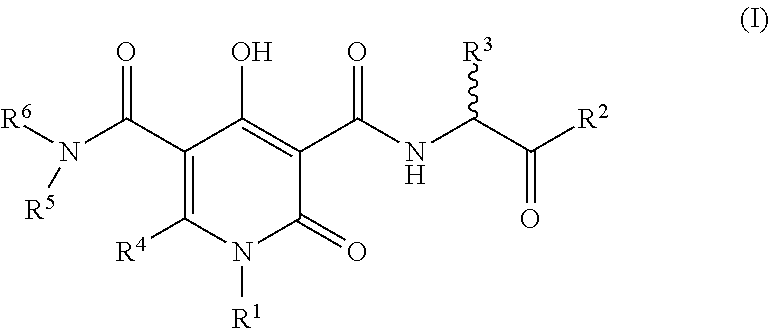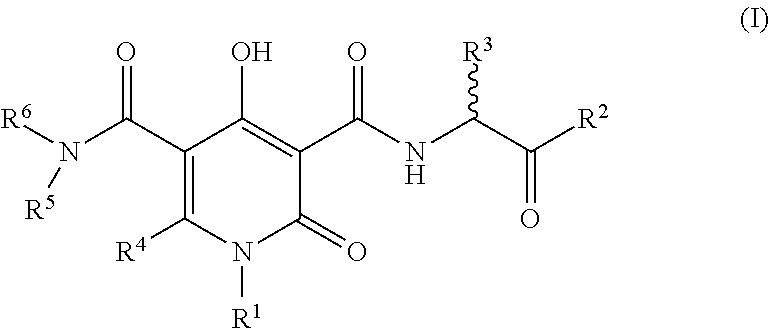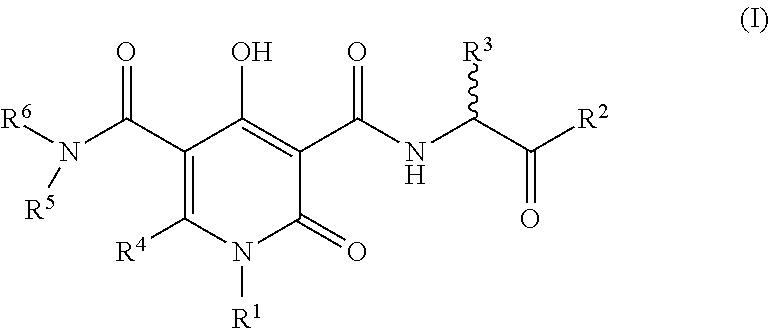Prolyl hydroxylase inhibitors
a technology of prolyl hydroxylase and inhibitor, which is applied in the direction of biocide, drug composition, extracellular fluid disorder, etc., can solve the problems of reduced oxygen levels in the blood, ubiquitination of hif-alpha and subsequent degradation, and achieve the effect of increasing the production of erythropoietin and epo
- Summary
- Abstract
- Description
- Claims
- Application Information
AI Technical Summary
Benefits of technology
Problems solved by technology
Method used
Image
Examples
example 1
N-{[1-[(2-chlorophenyl)methyl]-5-({[(2-chlorophenyl)methyl]amino}carbonyl)-2,4-dihydroxy-6-oxo-1,6-dihydro-3-pyridinyl]carbonyl}glycine
1a) 7-Chloro-2,2-dimethyl-4H,5H-pyrano[4,3-d][1,3]dioxin-4,5-dione. Malonyl dichloride (60.0 g, 426 mmol) in acetone (120 mL) was heated to gentle reflux for 15 minutes. The mixture was cooled over an ice bath and diluted with hexane (150 mL). The solid was collected, washed with hexane and dried in vacuo to give the title dione (21.0 g, 42%). 1H NMR (400 MHz, CHLOROFORM-d) δ ppm 6.18 (s, 1H), 1.81 (s, 6H).
1b) 7-{[(2-Chlorophenyl)methyl]-amino}-2,2-dimethyl-4H,5H-pyrano[4,3-d][1,3]dioxin-4,5-dione. 2-Chlorobenzylamine (2.96 mL, 24.5 mmoles) in dichloromethane (20 mL) was added dropwise to a cooled solution of 7-chloro-2,2-dimethyl-4H,5H-pyrano[4,3-d][1,3]dioxin-4,5-dione (2.83 g, 12.3 mmoles) in dichloromethane (80 mL). Cooling was removed and the mixture was stirred for 30 minutes. The solid was collected, washed with dichloromethane and dried to gi...
example 2
N-{[1-[(2-chlorophenyl)methyl]-5-({[(3,4-dichlorophenyl)methyl]amino}carbonyl)-4,6-dihydroxy-2-oxo-1,2-dihydro-3-pyridinyl]carbonyl}glycine
A mixture of methyl 1-[(2-chlorophenyl)methyl]-5-({[2-(ethyloxy)-2-oxoethyl]amino}carbonyl)-2,4-dihydroxy-6-oxo-1,6-dihydro-3-pyridinecarboxylate (350 mg, 0.798 mmoles) and 3,4-dichlorobenzylamine (281 mg, 1.6 mmoles) in 1,4-dioxane (10 mL) was sealed in a pressure tube and heated in a microwave reactor at 150° C. for 30 minutes. The mixture was diluted with ethyl acetate and washed with 1 molar hydrochloric acid. The aqueous layer was extracted with ethyl acetate and the combined extracts washed with 1 molar hydrochloric acid. The organic solution was dried, evaporated and purified by flash chromatography (dichloromethane). The required fractions were evaporated and suspended in ethanol (10 mL), treated with 1 molar sodium hydroxide solution (10 ml) and 6 molar sodium hydroxide solution (5 ml) and stirred overnight. The mixture was acidified and...
example 3
2,2′-{(1-cyclohexyl-4,6-dihydroxy-2-oxo-1,2-dihydropyridine-3,5-diyl)bis[(oxomethanediyl)imino]}diacetic acid
3a) 7-(Cyclohexylamino)-2,2-dimethyl-4H,5H-pyrano[4,3-d][1,3]dioxin-4,5-dione. A solution of 7-chloro-2,2-dimethyl-4H,5H-pyrano[4,3-d][1,3]dioxin-4,5-dione (2.97 g, 12.88 mmoles) in chloroform (45 mL) was treated dropwise with cyclohexylamine (2.95 mL, 25.88 mmoles) in chloroform (5 ml). The mixture was stirred for 1 hour, washed with water, 1 molar hydrochloric acid, dried and evaporated to give a pale yellow solid of the title dione (3.5 g, 95%). 1H NMR (400 MHz, DMSO-d6) δ ppm 9.06 (d, J=19.71 Hz, 1H), 5.00-5.56 (m, J=121.77 Hz, 1 H), 3.61 (s, 1H), 1.77-1.98 (m, 2H), 1.50-1.77 (m, 8H), 1.03-1.44 (m, 5H).
3b) Methyl 1-cyclohexyl-2,4-dihydroxy-6-oxo-1,6-dihydro-3-pyridinecarboxylate. Sodium methoxide (25 mL of a 25% solution in methanol) was added to a solution of 7-(cyclohexylamino)-2,2-dimethyl-4H,5H-pyrano[4,3-d][1,3]dioxin-4,5-dione (7.5 g, 25.6 mmoles) in methanol (100 m...
PUM
| Property | Measurement | Unit |
|---|---|---|
| weight | aaaaa | aaaaa |
| weight | aaaaa | aaaaa |
| weight | aaaaa | aaaaa |
Abstract
Description
Claims
Application Information
 Login to View More
Login to View More - R&D
- Intellectual Property
- Life Sciences
- Materials
- Tech Scout
- Unparalleled Data Quality
- Higher Quality Content
- 60% Fewer Hallucinations
Browse by: Latest US Patents, China's latest patents, Technical Efficacy Thesaurus, Application Domain, Technology Topic, Popular Technical Reports.
© 2025 PatSnap. All rights reserved.Legal|Privacy policy|Modern Slavery Act Transparency Statement|Sitemap|About US| Contact US: help@patsnap.com



